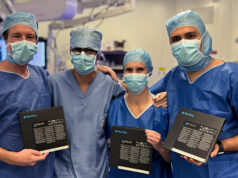
At the Vascular Annual Meeting (9–11 June, National Harbor, USA), data were presented suggesting that complex triple or quadruple fenestrated endovascular aneurysm repair (FEVAR) does not result in higher mortality or morbidity rates than standard double FEVAR in the treatment of complex aortic aneurysms.
“A long and durable proximal landing zone needs to be created whenever you use fenestrated grafts,” said Eric Verhoeven, Paracelsus Medical University, Nuremberg, Germany, who presented the findings. He continued, “Depending on the location of this landing zone, you will have to add fenestrations to your graft.” Currently, standard double FEVAR is used in short neck and some juxtarenal abdominal aortic aneurysms. However, Verhoeven explained, “When you do not have a suitable (ie. long enough) landing zone below the superior mesenteric artery, you will have to add a third and sometimes a fourth fenestration.” Triple or quadruple FEVAR has theoretical advantages when compared with standard double FEVAR, Verhoeven said, in that “you have the advantage of lengthening your landing zone, of choosing a landing zone that is more proximal, and probably of finding a healthier landing zone in the aorta, which may positively affect long-term durability.” However, adding extra fenestrations naturally makes both planning—with extra fenestrations to measure and better imaging required—and the procedure itself—due to increased duration—more complex.
Verhoeven and colleagues were investigating whether or not this increased complexity results in increased mortality and morbidity rates. Their series included 359 consecutive patients from 2010 to 2016 treated with FEVAR for short neck, juxtarenal and suprarenal abdominal aortic aneurysms. “I have to disclose,” Verhoeven said, “that of course our high-volume centre already had experience of this approach, so there was no learning curve in this experience and we benefitted greatly from having a perfect set-up with two Artis Zeego hybrid rooms [Siemens]”.
A total of 359 patients (296 males, mean age 72.5±7.8 years) were treated—198 (55.2%) with a standard double FEVAR, and 161 (44.7%) with complex triple or quadruple FEVAR. Over the period of the study, more complex fenestrations were used to treat the same pathology—in 2010, 81% of stents used were double fenestrated, which fell to 25% by 2016. “Overall, we became more liberal in adding fenestrations for the superior mesenteric artery,” Verhoeven said. All of the stent grafts used in this study were customised based on the Zenith system (Cook Medical).
Technical success was high at 97.5% overall. This was true for both standard double and triple or quadruple fenestrated groups. The more complex group reported a higher mean fluoroscopy time than the standard double FEVAR group.
Thirty-day mortality was 0.6% overall, with one case in each group. Major complications, at 10.6% overall, were reported at similar rates in the double and triple or quadruple groups.
“The interesting part of this would be the follow-up, but as with many endovascular series, follow-up was too short (mean duration of 21±15.2 months) to demonstrate any differences—we will have to wait for longer follow-up to see if this more liberal approach of adding fenestrations gives us more durable results,” Verhoeven noted.
There was no significant difference in estimated survival between standard double FEVAR and complex triple or quadruple FEVAR. Similarly, no significant difference was observed in target vessel patency rates between the double and triple or quadruple fenestration groups.
“More complex FEVAR obviously requires more complex planning, but this is not an issue,” Verhoeven told delegates. “The procedures take longer, but that does not seem to affect morbidity or mortality in our patients. The take-home message is that we are not at all hesitating to add fenestrations to our grafts to increase the length of the landing zone and to hopefully provide a more durable repair for our patients.”












